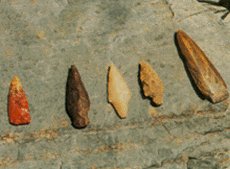Today, Homo Sapiens have been as far as the moon and have sent machines to the end of our solar system.

| Background:
Homo Sapiens have been around for around 30,000 years. Our ancestors were
Cro-Magnon. Homo Sapiens remains have been found all over the world. During
the early migration of early man, Homo Sapeins crossed Asia to North America
by crossing Beringia, or the land bridge. Scientists believe they followed
the herds across. Also, because the glaciers were receeding, a path was
created which made it possible for them to travel down through North, Central,
and South America.
Today, Homo Sapiens have been as far as the moon and have sent machines to the end of our solar system. |
 |
| Physical Description: Modern
men are distinct physically from all early Homo sapiens. With no brow ridges,
a thinner and more rounded skull, a higher forehead and a slightly projecting
chin, the average brain size is about 1350 millilitres. The oldest European skulls date to c. 30,000 years ago but Homo sapiens sapiens appeared at least 70,000 years ago, perhaps in Africa. This is very recent compared with the whole of human history. |
 |
 |
 |
|
Art:
Cro-Magnons
began a rich tradition of art. Starting with cave paintings, their art
reflected their daily struggle which revolved around hunters and animals.
Early man used natural colors.You may have heard that they used charcoal
to create these paintings. Actually, most art was not made with charcoal,
but rather with mineral pigments, such as iron oxide (red ochre) or black
manganese. They drew stick figures for people, but the animals were well
drawn, and usually filled in with natural colors, to give them even more
shape and substance.
The other thing found in cave paintings, besides stick figures of people
and well drawn animals, are stencils of hands. What were they saying? (I
was here? I made this?) Was this a way to sign their art? Or to prove they
had achieved their ... mission? It's not easy to figure out because not
all paintings include a stenciled handprint.
|
| HOMES: These
early men built permanent homes, to shelter from the long, harsh
winter of the Ice Age. In the summer, they followed the herds, and lived in tents. Winter homes were Ice Age huts, built tepee style, from branches and mammoth bones, covered with animal skins. These huts were used for many years, so they built them carefully. Holes were dug, deeply into the ground. Poles were inserted into these holes, and then tied tightly together at the point of the tepee, at the top, with string made from animal guts. Warm furs were laid over this structure and sewn tightly in place. Large rocks were piled around the bottom, to help hold the hut together. In the summer, the tribe moved, following the animals. They lived in
sturdy tents,
|
|
FOOD: These hunter-gatherers ate
a variety of seeds, berries, roots and nuts, as did their ancestors. They
also ate fish and seemed to have an ample supply of freshly caught game.
Their lives were not a constant struggle for survival because they were
such good hunters. They learned to organize hunts and to cure and store
food for the long winter. Hunting was done individually and in groups.
They used traps, which allowed them to catch food while they busy doing
something else. Fisherman used bows and arrows, nets woven from vines,
fish hooks, and even poisons. Some groups built rafts and canoes, to catch
bigger fish indeeper waters.
created by Mr. Sustal